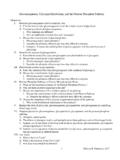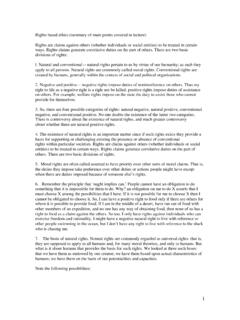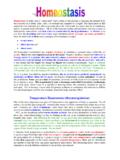Transcription of Gluconeogenesis, Glycogen Metabolism, and the Pentose ...
1 gluconeogenesis , Glycogen Metabolism, and the Pentose Phosphate Pathway Objectives: gluconeogenesis and its metabolic role. two reasons why gluconeogenesis is not the simple reverse of glycolysis. glycolysis and gluconeogenesis . enzymes are different? are additional enzymes involved / necessary? the control points of gluconeogenesis . enzyme(s) is(are) allosteric? the allosteric effectors and how they effect the enzymes. / Contrast the control points of gluconeogenesis with the control points of glycolysis. the process of glycogenolysis . the enzyme(s) that catalyzes glycogenolysis (the breakdown of Glycogen ). the control points of glycogenolysis . enzyme(s) is(are) allosteric? the allosteric effectors and how they effect the enzymes. the process of glycogenesis . the enzyme(s) that catalyzes glycogenesis (the synthesis of Glycogen ). the control points of glycogenesis . enzyme(s) is(are) allosteric? the allosteric effectors and how they effect the enzymes Phosphate Pathway or Hexose Monophosphate Shunt.
2 Are the important products of the Pentose Phosphate Pathway? are these products important to the cell? the importance of the oxidative phase of the pathway. the control points of the oxidative phase of the Pentose Pathway. a)Describe the allosteric effectors and how they effect the enzymes. the importance of the recovery (regeneration) phase of the pathway. is the biochemical importance of the products? the roles of glycolysis, gluconeogenesis , glycogenolysis , and glycogenesis in controlling blood sugar levels. glycolysis, gluconeogenesis , glycogenolysis , glycogenesis , and the Pentose phosphate pathway. control points. effects of glucagon, insulin, and epinephrine on these pathways and on blood sugar levels. the regulation of blood glucose levels by glycolysis, gluconeogenesis , glycogenesis and glycogenolysis in the liver. the regulation of glucose metabolism by glycolysis, gluconeogenesis , glycogenesis and glycogenolysis in skeletal muscle. Cycle is the Cori Cycle?
3 Is the function of the Cori Cycle? does it accomplish its function? Kevin R. Siebenlist, the Cori Cycle function indefinitely? yourself What If Questions ; , Blood glucose levels drop because of exercise, what hormone is released, which tissues respond, how??? Background Glycolysis, the TCA Cycle, and the Electron Transport/Oxidative Phosphorylation Pathway when functioning together generate a large quantity of ATP by the complete oxidation of glucose to CO2 and H2O. There are several enzymatic reactions and/or pathways that utilize carbohydrates that need to be examined. Pathways for: 1. the synthesis new glucose from three and four carbon metabolic intermediates 2. the synthesis of Glycogen from glucose 3. the release of glucose-6-phosphate and glucose from Glycogen for entry into metabolism need to be explored. Finally, the Pentose PHOSPHATE PAT H WAY (HEXOSE MONOPHOSPHATE SHUNT) will be discussed. This pathway serves three functions generates NADPH for reductive biosynthesis.
4 Generates ribose for nucleotide biosynthesis. converts excess pentoses into hexoses for entry into the other pathways of carbohydrate metabolism. gluconeogenesis The body strives to maintain a glucose concentration of about 1 mg/mL in the blood. It is maintained at this level in order to have a constant stable supply for the glucose dependent tissues. Four tissues are dependent upon glucose alone for energy generation. Red blood cells are absolutely glucose dependent since they have only glycolysis for energy generation. In the fed state, nervous tissue, adrenal medulla, and testis/ovaries use only glucose for their energy generation. In the starvation state these three tissues can adapt to other energy sources if the starvation comes on slowly. After a meal, Insulin stimulates all of the tissues of the body to absorb glucose from the blood and utilize it for energy generation and biosynthesis. Between meals, during a short fast, when blood glucose levels begin to fall, most tissues utilize fatty acids or amino acids to meet their energy needs sparing the glucose that remains for the four glucose dependent tissues.
5 Glucose is released from stored Glycogen and is synthesized to meet the needs of the glucose dependent tissues. gluconeogenesis is the synthesis of new glucose from three or four carbon precursors. The three carbon precursors for gluconeogenesis are lactate, pyruvate, and glycerol. Lactate is obtained from the constant anaerobic glycolysis in the Red Blood Cell and the occasional anaerobic glycolysis in Skeletal Muscle. Pyruvate is obtained primarily from amino acid catabolism, and glycerol is from triacylglycerol catabolism. Oxaloacetate is the four carbon precursor. It is obtained from excess TCA cycle intermediates and from amino acid catabolism. gluconeogenesis is a cytosolic process occurring primarily in the liver and kidney. Under normal conditions the liver performs about 90% of the gluconeogenesis in the human animal, kidney about 10%, and the small intestine less than 1%. The liver employs gluconeogenesis to maintain blood glucose levels using lactate, amino acid carbon skeletons, and glycerol as the starting materials.
6 gluconeogenesis in the kidney primarily employs the carbon skeletons of amino acids as Kevin R. Siebenlist, 20172precursors. The amino group is removed from the amino acid as NH4+ and used by the kidney to buffer excreted metabolic acids. During starvation kidney can perform up to 50% of the gluconeogenesis necessary to sustain the organism. Kidney takes over this process during starvation in order to produce sufficient NH4+ to buffer the metabolic acids and to free the liver for ketone body synthesis. The small intestine performs gluconeogenesis on the glycolytic intermediates released from the ingested food and absorbed by the cells of the small intestine. The resulting glucose is released into the blood. Skeletal muscle, while containing the enzymes required for gluconeogenesis , has a very limited gluconeogenic capacity (<1% of the glucose produced). The lactate produced by anaerobic glycolysis in skeletal muscle is transported to the liver and converted to glucose by the liver.
7 The subunit composition and Km of skeletal muscle lactate dehydrogenase would require extremely high concentrations of lactate in order for the lactate to pyruvate reaction to occur. The necessary concentration is difficult to attain in skeletal muscle due to the efficiency of the transporter that moves lactate from the cell into the blood. gluconeogenesis in skeletal muscle is primarily used to reduce the concentration of glycolytic intermediates after a bout of prolonged or extreme contraction. Skeletal muscle converts the intermediates prior to pyruvate back to glucose-6-phosphate and stores this glucose as Glycogen . Any pyruvate formed by prolonged contraction is either converted to lactate and the lactate is released to the liver for gluconeogenesis or when the muscle is again well oxygenated it is converted to acetyl-CoA for the TCA cycle. gluconeogenesis - The Pathway Entry of glycerol into gluconeogenesis will be discussed with triacylglycerol metabolism. This discussion centers around the utilization of lactate, pyruvate, and oxaloacetate for gluconeogenesis .
8 Since seven of the ten reactions of glycolysis are freely reversible, these same glycolytic enzymes are used during gluconeogenesis , but in the reverse direction. There are three irreversible steps in glycolysis, the reactions catalyzed by Pyruvate Kinase, Phosphofructokinase-1, and Hexokinase. Different enzymes must be used to bypass these irreversible steps during gluconeogenesis . With lactate, pyruvate, or oxaloacetate as the precursors, the first steps of gluconeogenesis is the conversion of these starting materials into phosphoenolpyruvate. Since the reaction catalyzed by Pyruvate Kinase is irreversible, a different set of enzymes need to be employed for this conversion. The conversion of each of these three precursors into phosphoenolpyruvate follow slightly different paths. Remember these reactions are occurring primarily in the liver ( 90%) and to a lesser extent in the kidney ( 10%), small intestine ( 1%), and skeletal muscle ( 1%). The lactate from anaerobic glycolysis (RBC always; skeletal muscle under stressed conditions) is converted to pyruvate by Lactate Dehydrogenase in the cytosol.
9 The pyruvate is transported from the cytosol into the mitochondria and once in the mitochondria the pyruvate is converted to oxaloacetate by the action of Pyruvate Carboxylase. The enzyme requires Biotin as a prosthetic group. This reaction is one of the anapleurotic reactions of the TCA cycle previously discussed. This new oxaloacetate is converted to phosphoenolpyruvate by the action of the mitochondrial isoenzyme of Phosphoenolpyruvate Carboxykinase (PEP Carboxykinase). The resulting phosphoenolpyruvate is transported out of the mitochondria for gluconeogenesis . Kevin R. Siebenlist, 20173 When pyruvate from amino acid catabolism is the starting material, the pyruvate is either produced in the Lactate Pyruvate Pyruvate Pyruvate Pyruvate Oxaloacetate Oxaloacetate MalateMalate OxaloacetatePhosphoenolpyruvate PhosphoenolpyruvateAmino Acids Amino Acids NAD NADH ATP + HCO3 ADP GDP + HCO3 GTP Lactate Dehydrogenase Pyruvate Carboxylase PEP Carboxykinase ATP + HCO3 ADP Pyruvate Carboxylase NADNADHNADNADHGDP + HCO3 GTPPEP CarboxykinaseMalate Dehydrogenase Malate DehydrogenaseH3 CCCOOOH2 CCCOOOPOOOOCCH2 CCOOOOOCCH2 CHCOOOHOH3 CCCOOOOCCH2 CCOOOO Kevin R.
10 Siebenlist, 20174mitochondria or transported from the cytosol to the mitochondria. Once in the mitochondria the pyruvate is converted to oxaloacetate by the action of Pyruvate Carboxylase. The oxaloacetate generated from pyruvate is then converted to malate by the action of the mitochondrial isoenzyme of Malate Dehydrogenase, the TCA cycle enzyme running in the reverse direction. Malate is transported from the mitochondria to the cytoplasm by a transport protein, and once in the cytoplasm it is converted back to oxaloacetate by the action of the cytoplasmic isoenzyme of Malate Dehydrogenase. The net result of these three reactions is the conversion of pyruvate in the cytoplasm to oxaloacetate and a NADH in the cytoplasm. Oxaloacetate in the cytoplasm is converted to phosphoenolpyruvate by the action of the cytoplasmic isoenzyme of Phosphoenolpyruvate (PEP) Carboxykinase. The resulting phosphoenolpyruvate enters gluconeogenesis . The starting material oxaloacetate is generated in the mitochondria from amino acid catabolism or it is drawn out of the TCA cycle to slow the pathway.






